Projects
Natural Environment Research Council: NE/T009292/1
PI: Chiara Petrone, NHM London; Co-I: Ralf Gertisser, Keele University
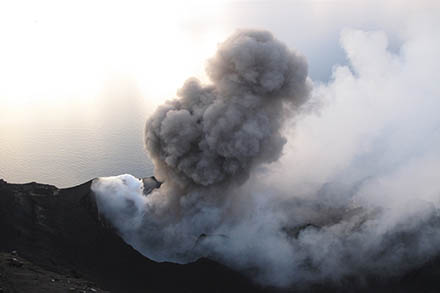
The project investigates the large volcanic explosion or “paroxysm” of Stromboli volcano in Southern Italy on 3 July 2019, which produced a ~ 4 km high ash column and caused one fatality.
Such paroxysms, which previously occurred in 2003 and 2007, infrequently interrupt the volcano’s persistent “normal” Strombolian activity which attracts large numbers of tourists to the island each year.
Stromboli’s paroxysms are often preceded by little to no warning signs, which makes them extremely dangerous. The eruptive behaviour in 2019 also appeared to be different from earlier paroxysms, as it was not preceded by lava effusion, previously interpreted to be a possible precursor sign to a large volcanic explosion.
An integrated, state-of-the-art petrological approach is used to yield new insights into the pre- and syn-eruptive magma plumbing system and the processes leading up to the 3 July 2019 paroxysm at Stromboli.
The project team includes Prof. Silvio Mollo (University Rome Sapienza, Italy), Dr Piergiorgio Scarlato (INGV, Italy) and Prof. Mark Reagan (University of Iowa, USA), alongside other colleagues in Italy and the UK.
Natural Environment Research Council: NE/ J00457X/1
PI: Brian O’Driscoll, Keele University
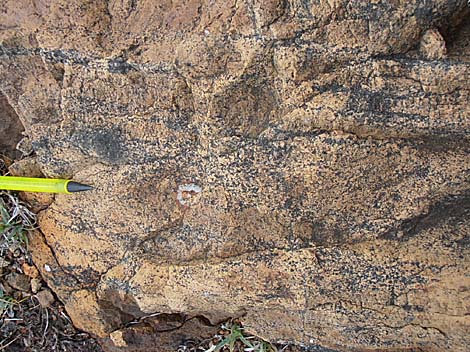 Although the terrestrial mantle comprises ~80 vol.% of our planet, its compositional architecture is not well understood despite the importance such knowledge holds for constraining Earth's thermal and chemical evolution over ~4.5 billion years of geological time. Our lack of detailed insight into the mantle stems in part from the fact that it is rarely exposed at our planet’s surface, making direct observation and study difficult. It is clear from recent study, however, that the mantle cannot be assumed to be compositionally homogenous or static over geological time. Peridotites from the ocean basins (abyssal peridotites) and from ophiolites preserve evidence for a convecting upper mantle that is chemically and isotopically heterogeneous at regional (100's km) and small (cm-to-m) scales. Complex formation and alteration upper mantle histories involving processes of melt-depletion, refertilisation (whereby originally refractory residues such as harzburgites become lherzolites again via melt addition) and melt-rock reaction have been held responsible, but the causes, timing and distribution of such processes are poorly resolved.
Although the terrestrial mantle comprises ~80 vol.% of our planet, its compositional architecture is not well understood despite the importance such knowledge holds for constraining Earth's thermal and chemical evolution over ~4.5 billion years of geological time. Our lack of detailed insight into the mantle stems in part from the fact that it is rarely exposed at our planet’s surface, making direct observation and study difficult. It is clear from recent study, however, that the mantle cannot be assumed to be compositionally homogenous or static over geological time. Peridotites from the ocean basins (abyssal peridotites) and from ophiolites preserve evidence for a convecting upper mantle that is chemically and isotopically heterogeneous at regional (100's km) and small (cm-to-m) scales. Complex formation and alteration upper mantle histories involving processes of melt-depletion, refertilisation (whereby originally refractory residues such as harzburgites become lherzolites again via melt addition) and melt-rock reaction have been held responsible, but the causes, timing and distribution of such processes are poorly resolved.
Ophiolites, which represent partially-to-wholly preserved slivers of obducted oceanic mantle, are particularly valuable resources for assessing the timing, causes and extent of mantle heterogeneity, as they allow field-based observation to be coupled with geochemical investigation on otherwise inaccessible mantle material. Furthermore, ophiolites preserve a range of oceanic mantle lithologies (e.g., harzburgites, lherzolite and dunite) and such variation allows detailed assessment of the distribution and relative timing of events acting upon the mantle that is preserved. A distinctive attribute of some ophiolites, which contrasts with abyssal peridotites, is the presence of podiform chromitite seams, typically in the region of the petrological Moho, which are often associated with Platinum-group element mineralization. The timing and genesis of ophiolite podiform chromitites is controversial, but it has been suggested that they represent zones of focused melt channeling in supra-subduction zone settings.
The Shetland (UK) and Leka (Norway) supra-subduction zone ophiolites comprise oceanic lithosphere separated at ~620 Ma on either side of a mid-ocean ridge and subsequently obducted over continental crust ~130 Ma later, each on opposite sides of the northern Iapetus Ocean. A pilot study already carried out on the Shetland ophiolite by the PI and Project Partner reveals that it preserves evidence for a complex sequence of melt depletion, percolation and refertilisation events that occurred over the lifetime of the Iapetus mantle. The critical observation made from the pilot dataset is that later mantle events only partially overprint the compositional heterogeneities developed from earlier mantle processes and that the relatively high degrees of partial melting associated with the supra-subduction zone are very effective at generating such heterogeneity. This important observation will be tested in the proposed research by
- extending the Shetland study to greater levels of detail;
- inclusion of a comparative study of carefully selected samples from the well-preserved Leka ophiolite;
- drawing comparisons with existing geochemical and isotopic datasets from ophiolites that formed in other (e.g., mid-ocean ridge) tectonic settings.
In order to achieve this, the powerful combination of the Re-Os isotopic system and highly-siderophile element (Os, Ir, Ru, Rh, Pt, Pd, Re, Au) abundance measurements will be utilised to discriminate between the processes responsible for generating mantle heterogeneities such as melt depletion, refertilisation and melt-rock reaction. Thus, profound insight will be gained into the chemical evolution of a piece of oceanic mantle and the development of compositional heterogeneity therein, from outcrop to oceanic plate scales, over much of the lifetime of the Iapetus Ocean.
Understanding the driving forces behind recent changes in the eruptive behaviour of Merapi volcano, Java, Indonesia
Natural Environment Research Council: NE/I029927/1 (completed 2012)
PI: Ralf Gertisser, Keele University; Co-Is: Jenni Barclay and Ricky Herd, University of East Anglia
In October and November 2010, Merapi volcano (Java, Indonesia) had its biggest eruption since 1872. Merapi, which literally means “Fire Mountain” in Javanese, is one of Indonesia’s most active and dangerous volcanoes with a history of deadly eruptions. Before 2010, these eruptions have usually been characterised by several months of viscous lava effusion at the summit of the steep-sided volcano, forming lava domes which, when big enough, collapse gravitationally generating relatively small pyroclastic flows.
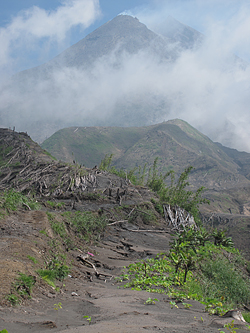 These flows are mixtures of lava dome fragments, smaller volcanic particles (ash) and hot gases that travel down the flanks of the volcano at high velocities of > 100 km/hour and, in the case of Merapi, typically reach distances of a few kilometres from the volcano. With a few exceptions only, this eruptive behaviour has been so typical of Merapi for at least the last two centuries that the pyroclastic flows generated by the gravitational failure of lava domes are often referred to in the literature as Merapi-type nuées ardentes (glowing clouds).
These flows are mixtures of lava dome fragments, smaller volcanic particles (ash) and hot gases that travel down the flanks of the volcano at high velocities of > 100 km/hour and, in the case of Merapi, typically reach distances of a few kilometres from the volcano. With a few exceptions only, this eruptive behaviour has been so typical of Merapi for at least the last two centuries that the pyroclastic flows generated by the gravitational failure of lava domes are often referred to in the literature as Merapi-type nuées ardentes (glowing clouds).
In 2010, the eruptive behaviour of Merapi has changed. The unforeseen, large-magnitude explosive events were very different to previous episodes that followed Merapi’s usual pattern of dome growth and collapse. On 26 October 2010, pyroclastic flows, generated during explosive eruption phases, swept down the flanks of the volcano, killing at least 34 people. The events were preceded by enhanced levels of seismicity and summit deformation that started in early September 2010.
After days of high level activity, with glowing avalanches from a newly formed lava dome, pyroclastic flows and sporadic explosions generating a 7-km-high, sustained eruption column on 4 November, an unusually large explosive eruption on 5 November generated pyroclastic flows that extended up to 15 km from the volcano. Associated surges swept across Merapi’s south flank, devastating villages and causing more fatalities. Since then, the death toll has risen to > 300 people, making this eruption the worst volcanic disaster at Merapi in 80 years.
This project seeks to exploit a “once-in-a-century” opportunityto capitalise on these unexpected events at Merapi through a detailed investigation of the rocks formed during the 2010 eruption. These rocks preserve a record of the sub-surface processes that operated inside the volcano before the eruption occurred. Through the use of modern micro-analytical techniques and measurements of different radioactive isotopes that decay quickly within months, decades or millennia in the rocks, we can unravel these processes (which are the driving forces behind the unusual explosive behaviour of Merapi in 2010) and their timescales.
The shortest radionuclide, 210Po, has a half-life of only 138 days and can tell us about the degassing of the magma and other processes that occurred in the weeks and months before the eruption. Because of its short half-life, 210Po must be analysed quickly after the eruption and before it has decayed completely to its daughter isotope 206Pb. Once we have established where in the crust beneath Merapi the magma feeding the 2010 eruption has come from and the processes of pre- and syn-eruptive crystallisation and degassing during magma ascent to the surface, we will compare the results with analytical data we have already collected on rock samples from the preceding eruptive episode in 2006, which followed Merapi “normal” (i.e. less explosive) eruptive behaviour.
Ultimately, we will attempt to link the results obtained by analysing the rocks from the eruptions to the surface manifestations of these processes (e.g., seismic signals, ground deformation, gas flux) recorded through continuous geophysical monitoring of the volcano by our Indonesian colleagues.
Natural Environment Research Council: NE/F000936/1 (completed 2009)
PI: Ralf Gertisser, Keele University

New insights into the deposit architecture and emplacement mechanisms of block-and-ash flows using ground penetrating radar.

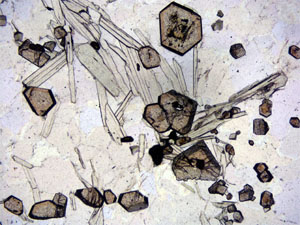 Boron (B) isotopes have great potential to track water cycling and fluid-rock interaction in metamorphic rocks from subduction zone settings. By investigating the boron concentrations and B isotope compositions of white mica, the major mineral host for boron, from a suite of well-characterised high-pressure metamorphic rocks, we will test the hypothesis that deeply subducted metamorphic rocks reflect dehydration in the down-going plate with increasing temperatures in their B contents and B isotope signatures. The effects of subsequent fluid-rock interaction during exhumation will be evaluated in chemically overprinted samples that exhibit step-like compositional zoning in white mica.
Boron (B) isotopes have great potential to track water cycling and fluid-rock interaction in metamorphic rocks from subduction zone settings. By investigating the boron concentrations and B isotope compositions of white mica, the major mineral host for boron, from a suite of well-characterised high-pressure metamorphic rocks, we will test the hypothesis that deeply subducted metamorphic rocks reflect dehydration in the down-going plate with increasing temperatures in their B contents and B isotope signatures. The effects of subsequent fluid-rock interaction during exhumation will be evaluated in chemically overprinted samples that exhibit step-like compositional zoning in white mica.
Natural Environment Research Council IP-1907-0619
PI: Ralf Gertisser; Co-I: Ralf Halama; Research student: Rebecca Wiltshire
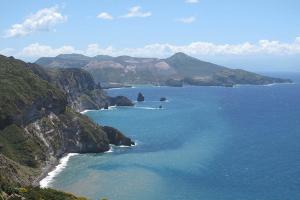 The project investigates the role of crustal assimilation and its influence on eruptive behaviour at the most recent and active intermediate to felsic (rhyolitic) volcanic centres in the Aeolian Islands. Key eruptions are selected that will allow us to decipher the effects and sources of crustal assimilation at different crustal depths, the stages during magma differentiation at which crustal assimilation occurs, and the influence of assimilation of different crustal lithologies on eruptive behaviour. The project is part of a Keele University-funded PhD project of Rebecca Wiltshire, which aims to understand the driving forces behind effusive and explosive eruptions, and transitions in eruptive style during multi-phase eruptions in the Aeolian arc, using fieldwork, petrology, geochemistry and rock textural analysis. Collaborators include Adrian Boyce, Federico Lucchi, Chiara Petrone, Claudio Tranne, Roberto Sulpizio and Sabrina Nazzareni.
The project investigates the role of crustal assimilation and its influence on eruptive behaviour at the most recent and active intermediate to felsic (rhyolitic) volcanic centres in the Aeolian Islands. Key eruptions are selected that will allow us to decipher the effects and sources of crustal assimilation at different crustal depths, the stages during magma differentiation at which crustal assimilation occurs, and the influence of assimilation of different crustal lithologies on eruptive behaviour. The project is part of a Keele University-funded PhD project of Rebecca Wiltshire, which aims to understand the driving forces behind effusive and explosive eruptions, and transitions in eruptive style during multi-phase eruptions in the Aeolian arc, using fieldwork, petrology, geochemistry and rock textural analysis. Collaborators include Adrian Boyce, Federico Lucchi, Chiara Petrone, Claudio Tranne, Roberto Sulpizio and Sabrina Nazzareni.
Natural Environment Research Council: NE/T009292/1
PI: Chiara Petrone, NHM London; Co-I: Ralf Gertisser, Keele University
 The project investigates the large volcanic explosion or “paroxysm” of Stromboli volcano in Southern Italy on 3 July 2019, which produced a ~ 4 km high ash column and caused one fatality.
The project investigates the large volcanic explosion or “paroxysm” of Stromboli volcano in Southern Italy on 3 July 2019, which produced a ~ 4 km high ash column and caused one fatality.
Such paroxysms, which previously occurred in 2003 and 2007, infrequently interrupt the volcano’s persistent “normal” Strombolian activity which attracts large numbers of tourists to the island each year.
Stromboli’s paroxysms are often preceded by little to no warning signs, which makes them extremely dangerous. The eruptive behaviour in 2019 also appeared to be different from earlier paroxysms, as it was not preceded by lava effusion, previously interpreted to be a possible precursor sign to a large volcanic explosion.
An integrated, state-of-the-art petrological approach is used to yield new insights into the pre- and syn-eruptive magma plumbing system and the processes leading up to the 3 July 2019 paroxysm at Stromboli.
The project team includes Prof. Silvio Mollo (University Rome Sapienza, Italy), Dr Piergiorgio Scarlato (INGV, Italy) and Prof. Mark Reagan (University of Iowa, USA), alongside other colleagues in Italy and the UK.

